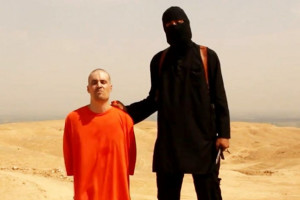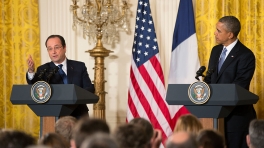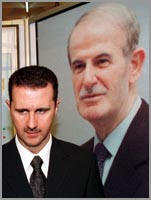The Paris and Brussels attacks are blowback from what Islamic State terrorists see as betrayal by Western benefactors who thought using jihadists could bring “regime change” in Syria, says Pakistani analyst Nauman Sadiq.
By Nauman Sadiq
France under President Nicolas Sarkozy played a lead role in fomenting the insurgency against the Gaddafi regime in Libya in 2011, and Sarkozy’s successor, Francois Hollande, has been on the forefront of supporting the Sunni militants in Syria against the Alawite-Shi’a regime of Bashar al-Assad.
This arrangement of an informal pact between the Western powers and the Sunni jihadists of the Middle East against the Shi’a-Iranian axis worked well – at least for the Western powers and the Sunni jihadists – up to August 2014, when Obama Administration made an about-face on its previous “regime change” policy in Syria and started conducting air strikes against one group of Sunni jihadists battling against the Assad regime, the Islamic State.

Journalist James Foley shortly before he was executed by an Islamic State operative on Aug. 19, 2014.
The Islamic State had transgressed the prescribed mission of “regime change” in Syria and overran Mosul and Anbar in Iraq. The Islamic State also threatened the capital of another steadfast American ally: Masoud Barzani’s Erbil in the oil-rich Iraqi Kurdistan — and began decapitating Western hostages.
(However, other Sunni jihadist forces, such as Al Qaeda’s Nusra Front and its close ally, Ahrar al-Sham, continued to focus on ousting Assad and thus continued receiving Western weapons, including U.S.-made TOW missiles that were crucial for last year’s successful offensive by the Saudi-backed Army of Conquest in Syria’s Idlib Province.)
After the West’s 2014 shift in the Syrian strategy (bombing Islamic State forces both in Iraq and Syria) and the Russian military intervention in 2015 on the side of Syria’s Alawite-Shi’a regime, the momentum of Sunni jihadists’ expansion in Syria stalled. Many now feel that their Western “allies” betrayed the Sunni jihadist cause, engendering bitterness and a desire for revenge.
If we look at the chain of events, the timing of Paris and Brussels attacks is critical: Islamic State overran Mosul in June 2014; the Obama administration started bombing Islamic State’s targets in Iraq and Syria in August 2014; and the first Islamic State incident of terrorism on Western soil took place at the offices of Charlie Hebdo in January 2015, followed by the November 2015 Paris attacks and the March 2016 Brussels bombings.
Moreover, the declassified Defense Intelligence Agency’s report of 2012 that presaged the imminent rise of a Salafist principality in northeastern Syria was not just overlooked, it was deliberately suppressed, not only the report but the view in general that a civil war in Syria would give birth to radical Islamists. That warning was forcefully stifled in the Western policy-making circles under pressure from the Zionist lobbies, which wanted “regime change” in Syria.
So, the Western powers were fully aware of the consequences of their actions in Syria but kept pursuing the policy of financing, training, arming and internationally legitimizing the so-called “Syrian opposition” to weaken the Syrian regime and to neutralize the threat that its Lebanon-based proxy, Hezbollah, posed to Israel’s regional security, a fact that has alarmed the Israeli defense community since the 2006 Lebanon war during which Hezbollah fired hundreds of rockets into northern Israel.
Those rockets were unguided but it was a wakeup call for the Israeli military strategists about what could happen if Iran passed guided-missile technology to Hezbollah whose area of operations lies very close to the northern borders of Israel. The Western interest in the Syrian civil war is primarily about ensuring Israel’s regional security (by creating a break in the so-called “Shiite crescent” running from Tehran through Baghdad and Damascus to Beirut).
Turkish Dilemma
In the wake of the Ghouta chemical weapons attack outside Damascus on Aug. 21, 2013, the stage was all set for yet another “humanitarian intervention” like the one against Gaddafi’s Libya in 2011; the war hounds were waiting for the finishing strike against Assad. Turkish Foreign Minister Ahmet Davutoglu and Saudi intelligence chief Bandar bin Sultan shuttled between the Western capitals to lobby for military intervention. Francois Hollande had already announced his approval and David Cameron was also onboard.

President Barack Obama holds a press conference with French President Francois Hollande at the White House on Feb. 11, 2014. (White House photo)
Here it should be remembered that even during the Libyan intervention President Obama’s policy was a bit ambivalent and France under the leadership of Sarkozy had taken the lead role. In the Syrian case, however, the British parliament forced Cameron to seek a vote for military intervention in the House of Commons before committing British troops and Air Force to Syria.
Taking this cue from the British parliament, the U.S. Congress also pressed Obama to seek approval before another military intervention; and since both those administrations lacked the requisite majority in their respective legislatures and because public opinion was also against another Middle Eastern war, Obama and Cameron dropped their plans of bombing Assad’s military and imposing a no-fly zone over Syria. (Obama also was confronted with U.S. intelligence analysts doubting that Assad’s forces were responsible for the sarin attack.)
In the end, France was left alone as the only Western power still in favor of intervention; at this point, however, the seasoned Russian Foreign Minister Sergei Lavrov staged a diplomatic coup by announcing that the Syrian regime was willing to ship its chemical weapons’ stockpiles out of Syria and subsequently the issue was amicably resolved.
Turkey, Jordan and the Gulf Arab states – the main beneficiaries (and benefactors) of the Sunni jihad in Syria, however, had lost a golden opportunity for dealing a fatal blow to the Shi’a alliance comprising Iran, Syria and their Lebanon-based proxy, Hezbollah.
Then, the Islamic State, one of the numerous Sunni jihadist outfits fighting in Syria, exceeded its mandate in Syria and overran Mosul in northern Iraq in June 2014 and threatened the capital of America’s most steadfast ally in the oil-rich region – Kurdish leader Masoud Barzani’s Erbil. (The Islamic State also engaged in high-profile decapitations of U.S. and Western hostages.)
The U.S. had no choice but to adopt some countermeasures to show to the world that it was still sincere in pursuing its schizophrenic and hypocritical “war on terror” policy; at the same time, it assured its Turkish, Jordanian and Gulf Arab allies that despite fighting a symbolic war against the maverick jihadist outfit, the Islamic State, the Western policy of training and arming the so-called “moderate Syrian rebels” would continue apace and that Bashar al-Assad’s days were numbered, one way or the other.
Moreover, declaring war against the Islamic State in August 2014 served another purpose – in order to commit the U.S. Air Force to Syria and Iraq, Obama Administration needed the approval (or at least the acquiescence) of Congress, but by declaring war against the Islamic State as a designated terrorist organization, the Obama Administration could avail itself of the “war on terror” provisions that had existed since the 9/11 attacks.
(So, while the U.S. and its allies launched aerial assaults against the Islamic State, TOW missiles and other weapons systems were still being delivered to the Saudi-organized Army of Conquest for its 2015 offensive against the Syrian army in Idlib Province, which also helped enable the Islamic State to seize Palmyra and surrounding Syrian territory.)
But then Russia threw a wrench into this scheme of NATO and its Gulf Arab allies. In September 2015, Russia pulled off a military buildup in its Syrian base at Latakia that had an element of surprise unheard of since Rommel, the Desert Fox. (The Russians then launched an air offensive against Al Qaeda’s Nusra Front, Ahrar al-Sham and other rebel forces, including the Islamic State, enabling Assad’s Syrian army to regain the offensive.)
Turkey, Jordan, the Gulf Arab states and their Sunni jihadist proxies in Syria found themselves on the receiving end in the Syrian civil war. Turkey’s shooting down of the Russian jet in November 2015 seemed like a desperate attempt by a NATO member to provoke Russia into a military encounter against Turkey and thus invoke NATO’s treaty obligation of “collective defense” in the face of “aggression” against any of NATO’s member states.
Structure of Islamic State:
The only difference between the Afghan jihad back of the 1980s, which spawned an Islamic jihadist movement with the Taliban and Al Qaeda for the first time in history, and the Libyan and Syrian jihads since 2011 is that the Afghan jihad was more overt – with the Western political establishments and their mouthpieces in the mainstream media openly bragging about how the CIA was providing all those AK-47s, RPGs and Stingers to the Pakistani ISI which then forwarded them to the Afghan mujahedeen to combat Soviet troops trying to bolster the pro-Moscow secular regime in Kabul.
After the 9/11 attacks, however, the Western political establishments and corporate media have become a lot more circumspect. Therefore, this time around they instigated covert jihads against the Gaddafi regime in Libya and the Assad regime in Syria, selling the Islamic jihadists to the Western audience as “moderate rebels” with secular and nationalist ambitions.

Syrian President Bashar al-Assad in front of a poster of his father, Hafez al-Assad.
Since the “regime change” objective in those hapless countries went against the established mainstream narrative of “the war on terror” – after all, Muammar Gaddafi and Bashar al-Assad ran largely secular regimes and claimed to be fighting Islamic jihadist terrorists – the Western political establishments and the mainstream media had to muddle the reality by offering color-coded schemes to identify gradations of militant and terrorist outfits that have operated in those countries – like the “red” militants of Islamic State which the Western powers want to eliminate; the “yellow” militants of the Army of Conquest, which includes Al Qaeda’s Nusra Front and Ahrar al-Sham, with whom NATO can collaborate under certain circumstances; and the “green” militants of Free Syria Army (FSA) and a few other inconsequential outfits which together comprise the so-called “moderate Syrian opposition.”
It’s an incontrovertible fact that more than 90 percent of the militants who are operating in Syria are either the Islamic jihadists or armed tribesmen, and less than 10 percent are those who have defected from the Syrian army or otherwise have secular and nationalist goals.
As far as the infinitesimally small secular and liberal elite of the developing countries is concerned, such privileged classes can’t even cook breakfasts for themselves if their servants are on a holiday and the corporate media has us believing that the majority of the Syrian militants are “moderate rebels” who constitute the vanguard of the Syrian opposition.
Notwithstanding, it is a fact that morale and ideology play an important role in the battle; moreover, we also know that the Takfiri brand of most jihadists these days has been directly inspired by the Wahhabi-Salafi ideology of Saudi Arabia, but ideology alone is never sufficient to succeed in the battle.
Looking at the Islamic State’s spectacular gains in Syria and Iraq in the last couple of years, one wonders where its recruits get all the training and sophisticated weapons that are imperative not only for hit-and-run guerrilla warfare but also for capturing and holding vast swathes of territory? Even the Afghan National Army, which has been trained and armed by NATO’s military instructors, is finding itself in trouble these days trying to hold territory in Afghanistan in the face of the unrelenting Taliban insurgency.
Apart from the CIA’s training and arms that are provided to the Islamic jihadists in the training camps located on the Turkish and Jordanian border regions adjacent to Syria in collaboration with the Turkish, Jordanian and Saudi intelligence agencies, another factor that has contributed to the spectacular success of the Islamic State is that its top cadres are comprised of the former Baathist military and intelligence officers of the Saddam regime.
According to a highly informative August 2015 Associated Press report, hundreds of ex-Baathists constitute the top-tier command structure of the Islamic State, planning all the operations and directing its military strategy.
Moreover, the U.S. State Department appears to be quite “worried” these days about where Islamic State jihadists get all the sophisticated weapons and especially those fancy, white Toyota pick-up trucks mounted with machine guns, colloquially known as “The Technicals” among the jihadists?
I think that I have found the answer to this riddle in an unprecedented December 2013 report: “Syrian rebels get arms and advice through secret command center in Amman,” from a website affiliated with the UAE government which is highly biased in favor of the Syrian opposition: it clearly mentions that along with AK-47s, RPGs and other military gear the Saudi government provides machine gun-mounted Toyota pick-up trucks to every batch of five jihadists who have completed their training in the border regions of Jordan or Saudi Arabia.
Once those jihadists cross over to Daraa and Quneitra in Syria from the Jordan-Syria border then those Toyota pick-up trucks can easily travel all the way to Raqaa and Deir ez-Zor and thence to Mosul and Anbar in Iraq.
While we are on the subject of Islamic State’s weaponry, it is generally claimed in the mainstream media that the Islamic State came into possession of those sophisticated weapons when it overran Mosul in June 2014 and seized huge caches of weapons that were provided to the Iraqi armed forces by the Americans during the occupation years.
On empirical grounds, however, is it not a bit paradoxical that Islamic State conquered large swathes of territory in Syria and Iraq before it overran Mosul, when supposedly it did not have those sophisticated weapons, and since allegedly coming into possession of those weapons it has been losing ground?
The only conclusion that can be drawn from this fact is that the Islamic State had those cutting-edge weapons, or equally lethal weapons, before it overran Mosul and that those weapons were provided to all the Sunni jihadist groups in Syria, including the Islamic State, by the intelligence agencies of the Western powers, Turkey and the Gulf Arab states.
Maintaining ‘Credibility’
In order to create a semblance of objectivity and fairness, the American policy-makers and analysts are always willing to accept the blame for the mistakes of the distant past that have no bearing on the present and the future. However, any fact that impinges on their present policy is conveniently brushed aside.
In the case of the formation of the Islamic State, for instance, U.S. policy analysts are willing to concede that invading Iraq back in 2003 was a mistake that radicalized the Iraqi society, exacerbated the sectarian divisions and gave birth to a Sunni insurgency against the heavy-handed and discriminatory policies of the Shi’a-dominated Iraqi government; similarly, the “war on terror”-era political commentators “generously” accept that the Cold War-era policy of nurturing Al Qaeda, the Taliban and myriads of other Afghan “freedom fighters” against the Soviets may have been a bit of a mistake. But these admissions have little or no bearing on the present policy.

The U.S. military’s “shock and awe” bombing of Baghdad at the start of the Iraq War, as broadcast on CNN.
The corporate media’s spin doctors conveniently forget that the formation of Islamic State and the new generation of Sunni Arab jihadist groups in Syria and Iraq have as much to do with the unilateral invasion of Iraq back in 2003 under the previous Bush administration’s policies as they have to do with the Obama administration’s Syrian policy of funding, arming, training and internationally legitimizing the Sunni militants against the Syrian regime since 2011 in the wake of the Arab Spring uprisings in the Middle East and North Africa.
If the Obama administration stops providing money, arms and training to the so-called “moderate rebels” and declares them terrorists (Islamic jihadists) – and makes sure its Mideast “allies” do the same – the insurgency in Syria would likely fizzle out within months, at least, in the densely-populated urban Syria from Damascus and Homs to Hamah, Idlib and Aleppo and the coastal Latakia. Northern Syria will likely remain under the control of the Kurds (who are seeking an autonomous zone in a federated Syria).
But central and eastern Syria from Raqqa to Deir ez-Zor which is dominated by the Islamic State, is a different ball game. It will take years to subdue the insurgency in those rural-tribal areas of Syria, if at all.
Beyond funding, training and arming these insurgencies, there is the international legitimacy that the West can bestow on these rebel or jihadist movements, as was done for the Afghan “freedom fighters” during the Cold War and for the “moderate and democratic” Libyan and Syrian insurgencies of today.
It is simply beyond the power of minor regional players and their nascent media, with their geographically and linguistically limited audience, to cast such brutal insurrections in a positive light, to give them international legitimacy. Only the Western mainstream media with its global audience – serving as the mouthpiece of the Western political establishments – has perfected this absurdist game of selling satans as saviors.
Nauman Sadiq is an Islamabad-based attorney, columnist and geopolitics’ analyst who has a particular interest in the politics of Af-Pak and MENA regions, neo-colonialism and petro-imperialism.
Comments
Post a Comment